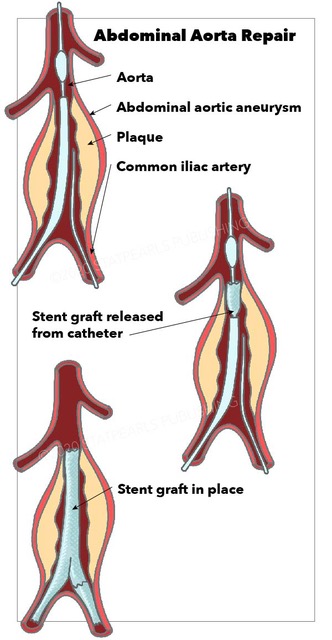[1]
Qazi AA, Jaberi A, Mironov O, Addas J, Qazi E, Tarulli E, Simons M, Tan KT. Conservative management of type 1A endoleaks at completion angiogram in endovascular repair of infra-renal abdominal aortic aneurysms with current generation stent grafts. Vascular. 2019 Apr:27(2):168-174. doi: 10.1177/1708538118811206. Epub 2018 Nov 5
[PubMed PMID: 30396328]
[2]
Oikonomou K, Kasprzak P, Schierling W, Kopp R, Pfister K. [Indications for the Use of Endoanchors: State of the Art]. Zentralblatt fur Chirurgie. 2018 Oct:143(5):503-509. doi: 10.1055/a-0746-3679. Epub 2018 Oct 24
[PubMed PMID: 30357794]
[3]
Sakalihasan N, Michel JB, Katsargyris A, Kuivaniemi H, Defraigne JO, Nchimi A, Powell JT, Yoshimura K, Hultgren R. Abdominal aortic aneurysms. Nature reviews. Disease primers. 2018 Oct 18:4(1):34. doi: 10.1038/s41572-018-0030-7. Epub 2018 Oct 18
[PubMed PMID: 30337540]
[4]
Desole A, Ferrari A, Tosato F, Milite D. Open Repair for Juxtarenal Aortic Aneurysm: Short and Long-term Results. Annals of vascular surgery. 2019 Jan:54():161-165. doi: 10.1016/j.avsg.2018.05.071. Epub 2018 Aug 6
[PubMed PMID: 30092431]
[5]
Carino D, Sarac TP, Ziganshin BA, Elefteriades JA. Abdominal Aortic Aneurysm: Evolving Controversies and Uncertainties. The International journal of angiology : official publication of the International College of Angiology, Inc. 2018 Jun:27(2):58-80. doi: 10.1055/s-0038-1657771. Epub 2018 May 29
[PubMed PMID: 29896039]
[6]
Wallinder J, Georgiou A, Wanhainen A, Björck M. Prevalence of Synchronous and Metachronous Aneurysms in Women With Abdominal Aortic Aneurysm. European journal of vascular and endovascular surgery : the official journal of the European Society for Vascular Surgery. 2018 Sep:56(3):435-440. doi: 10.1016/j.ejvs.2018.05.015. Epub 2018 Jun 20
[PubMed PMID: 29935861]
[7]
Niclot J, Stansal A, Saint-Lary O, Lazareth I, Priollet P. [Identifying barriers to screening for abdominal aortic aneurysm in general practice: Qualitative study of 14 general practitioners in Paris]. Journal de medecine vasculaire. 2018 May:43(3):174-181. doi: 10.1016/j.jdmv.2018.03.002. Epub 2018 Apr 25
[PubMed PMID: 29754727]
Level 2 (mid-level) evidence
[8]
Paraskevas KI, Gloviczki P. Some asymptomatic abdominal aortic aneurysms smaller than 5.5 cm can be considered for elective repair. Journal of vascular surgery. 2018 Jun:67(6):1645-1648. doi: 10.1016/j.jvs.2018.01.042. Epub
[PubMed PMID: 29685510]
[9]
Huang Y, Gloviczki P, Duncan AA, Kalra M, Oderich GS, Fleming MD, Harmsen WS, Bower TC. Maximal aortic diameter affects outcome after endovascular repair of abdominal aortic aneurysms. Journal of vascular surgery. 2017 May:65(5):1313-1322.e4. doi: 10.1016/j.jvs.2016.10.093. Epub 2016 Dec 27
[PubMed PMID: 28034585]
[10]
Laroche JP, Becker F, Baud JM, Miserey G, Jaussent A, Picot MC, Bura-Rivière A, Quéré I. [Ultrasound screening of abdominal aortic aneurysm: Lessons from Vesale 2013]. Journal des maladies vasculaires. 2015 Dec:40(6):340-9. doi: 10.1016/j.jmv.2015.07.104. Epub 2015 Sep 12
[PubMed PMID: 26371387]
[11]
Sidloff DA, Stather PW, Choke E, Bown MJ, Sayers RD. A systematic review and meta-analysis of the association between markers of hemostasis and abdominal aortic aneurysm presence and size. Journal of vascular surgery. 2014 Feb:59(2):528-535.e4. doi: 10.1016/j.jvs.2013.10.088. Epub
[PubMed PMID: 24461868]
Level 1 (high-level) evidence
[12]
Desjardins B, Dill KE, Flamm SD, Francois CJ, Gerhard-Herman MD, Kalva SP, Mansour MA, Mohler ER 3rd, Oliva IB, Schenker MP, Weiss C, Rybicki FJ, American College of Radiology. ACR Appropriateness Criteria® pulsatile abdominal mass, suspected abdominal aortic aneurysm. The international journal of cardiovascular imaging. 2013 Jan:29(1):177-83. doi: 10.1007/s10554-012-0044-2. Epub 2012 May 27
[PubMed PMID: 22644671]
[13]
Kuziez MS, Picus D, Sanchez LA, Zayed MA. Trans-luminal repair of a ruptured AAA with Type Ia and Type II endoleaks. Journal of surgical case reports. 2018 Oct:2018(10):rjy254. doi: 10.1093/jscr/rjy254. Epub 2018 Oct 8
[PubMed PMID: 30310643]
Level 3 (low-level) evidence
[14]
Ribner AS, Tassiopoulos AK. Postoperative Aortic Neck Dilation: Myth or Fact? The International journal of angiology : official publication of the International College of Angiology, Inc. 2018 Jun:27(2):110-113. doi: 10.1055/s-0038-1649516. Epub 2018 May 23
[PubMed PMID: 29896043]
[15]
Wang T, Zhao J, Yuan D, Ma Y, Huang B, Yang Y, Zeng G. Comparative effectiveness of open surgery versus endovascular repair for hemodynamically stable and unstable ruptured abdominal aortic aneurysm. Medicine. 2018 Jul:97(27):e11313. doi: 10.1097/MD.0000000000011313. Epub
[PubMed PMID: 29979402]
Level 2 (mid-level) evidence
[16]
Hallett RL, Ullery BW, Fleischmann D. Abdominal aortic aneurysms: pre- and post-procedural imaging. Abdominal radiology (New York). 2018 May:43(5):1044-1066. doi: 10.1007/s00261-018-1520-5. Epub
[PubMed PMID: 29460048]

